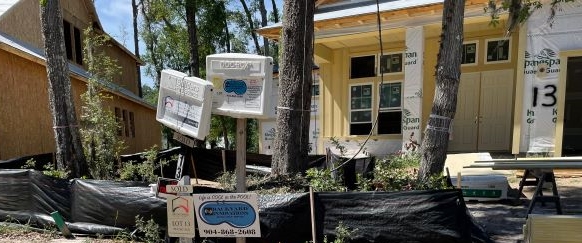 By Margaret Kirkland
By Margaret Kirkland
Chair of
Amelia Tree Conservancy
July 4, 2022

At the June 21 City Commission meeting, Julie Ferreira and Commissioner Kreger expressed concern regarding the weak protection of our mature trees in Fernandina Beach. Mike Lednovich immediately put this item on the agenda for the July 5 Commission Workshop. Amelia Tree Conservancy (ATC) shares these concerns and hopes the community will attend. This problem needs to be addressed in order to establish a culture in the City that supports our mature canopy.

Section 4.05.14 of the Fernandina Beach Land Development Code is quite specific regarding many factors related to the handling of trees during development, such as the establishment of tree protection zones (TPZ) in specific locations with certain materials and dimensions, mulching, not storing materials and equipment within the TPZ, and trenching near trees. Unfortunately, these regulations are not being adequately enforced. My May 6 message to the Urban Forester and Planning and Conservation Director related to construction on 1st Ave. south of Sadler and in Amelia Bluff.
Over the years, we have also seen consistent damage done by staff charged with maintaining rights of way (ROW) and public spaces (for example, Bosque Bello and the trees in the ROW at the ball fields on Hickory). All of this was brought to the attention of Commissioners and staff repeatedly.
Why does this matter?

Ignoring tree loss and how it relates to climate change will hasten unbearably hot temperatures and extensive flooding. Even the most conservative professional organizations now point to the importance of 1) preparing for resiliency and sustainability; 2) rethinking their previous approaches; and 3) utilizing nature-based approaches such as land conservation, wetland protection and living shorelines wherever possible. On a barrier island, this includes protection and strengthening of our dunes, protection and strengthening of our river shoreline, protection of wetlands and flood zones, land conservation and protecting our tree canopy. Addressing these elements of our environment successfully will also keep our flood insurance rates as low as possible, reduce exorbitant long-range expenses for flood/storm damage and more dramatic resiliency efforts, facilitate the acquisition of grant funding, and optimize our quality of life.
What do we need to do to protect our mature canopy?
- Clearly, we need to enforce the regulations we already have and ensure proper maintenance of public spaces. There has been some positive progress recently, but we need to go much farther.
- The City has conserved some parcels. We need to continue to conserve as much as possible.
Sierra Club partnered with the City to provide training for the Urban Forester and other staff who care for the trees in our City. Danny and Chuck Lippi, Master Arborists who are among the most highly respected arborists in the state, provided a series of training sessions. Unfortunately, according to Ms. Ferreira and Commissioner Kreger, their training is not necessarily being applied. We need to ensure that those working with our trees, parks and rights of way are well trained and supervised by credentialed staff. - The Planning and Conservation Department has awakened public interest in Heritage Trees. We need to maintain and expand this effort, which ATC is supporting.
- The City, Keep Nassau Beautiful and community members have been planting trees. Since these trees will not be able to contribute significantly to our resiliency and sustainability for many years, we need to continue planting, maintain our mature trees and develop a succession plan to replace trees that die.
Perhaps most important is that we need to establish a culture that protects our trees. To a large extent, this depends on the actions, attitudes and communication of those at the top. Whatever Commissioners, the City Manager, other Charter Officers, the Assistant City Manager and department heads do and communicate impacts any effort in the City. So, it is critical that 1) all in these positions be knowledgeable, 2) regulations of various departments be coordinated and mutually supported and 3) they exhibit leadership in the establishment of a culture that encourages staff and citizens to build a strong future for our canopy, our residents and our guests.

Thank you, Margaret, for bringing this workshop to our attention. This fight is one of the most important for our growing community. Awareness of the role that the tree canopy plays in environmental sustainability is critical to moving forward. Kudos to all who are working with the Amelia Tree Conservancy to protect Amelia Island.
Dear Margaret,
Studies repeatedly now show that trees lower temperatures, provide oxygen, remove carbon and provide a habitat for hundreds of seen creatures and millions of micro-organisms. It just makes sense to preserve and protect them, whenever possible. Inconvenience for the sake of developers and city infrastructure, is a weak excuse and has to be mitigated by laws with teeth, that can forcefully protect the tree canopy.
Perfect letter informing the community the need to protect our trees! The trees are our soldiers standing tall protecting us—we need to protect them!
Why not utilize interested citizens to help monitor certain building sites? I have grieved over the clear cutting that was allowed at The Conclave More sites are being cleared for future building along A1A as we speak.
In addition to all of the environmental factors for protecting our trees, there is the “Sense of Place” that the trees provide. Trees are a vital part of the character of Amelia Island and they need to be preserved.
Yes, this also makes them critical for much of our economy.
I agree with almost everything here, but I would be cautious regarding claims of ‘ resilience’ regarding trees. Every year billions in damages and even death result from falling trees. If a tree falls on your home causing thousands of dollars damage, is that resilience? How about damage to infrastructure, such as the power grid? And, God forbid, if you or a loved one could not get emergency medical care because roads are blocked by fallen trees or limbs, how does that square with resilience?
Again, your goals are admirable, but you have to be careful regarding claims without solid evidence in support.
Men in trucks with chainsaws that only see trees as a way to make money are a dangerous threat to our community. Please call local law enforcement if anybody is trying to pressure you into removing a tree on your property. Nobody has ever died around here because of a tree falling and, the roofs on most houses on Amelia Island are tough enough to withstand damage from falling trees. Trees reduce wind velocity damage and, absorb flood water. Trees protect us. They reduce our insurance rates & our power bills. Lets work together to keep our tree canopy healthy.
Value for the trees must start from the top within the City. What is left of the City canopy, the trees and their understory, ought to have a dedicated chapter in the Land Development Code. As it stands, Fernandina’s tree protections are published within the Land Development Code under Chapter 4 which is titled Site Design pertaining to construction. There are 45 pages of details regarding construction under Site Design. The specific details regarding tree protections are not addressed until page 38 of 45. The code enforcement and penalties for violations of tree ordinances are not in this same chapter. They are found in LDC Chapter 11 , on page 27.
Addressing violations of the tree protections under this City code have been the burden of citizen initiated reports to the code enforcement official. But citizen oversight is dependent upon a knowledge of the the existence and language of the tree protections code and a willingness to report. How many residents are likely to read the Land Development Code except perhaps for a particular section that impacts them?
If a person purchases an existing house, he or she may never be a need to go to Chap. 4 and would be unaware of tree protections.
There was only one code enforcement official on staff when I first called to report a violation. She handled all violations for the entire city not just trees.
Often violations go unreported because, understandably, neighbors do not want to create ill will among the neighborhood. And because the reports that are made to code enforcement happen after the violation has occurred the damage to a tree is already done. Prevention is vital for tree protection.
City staff in the building department have the best and most frequent opportunities to observe the existence of proper tree protections zones before and throughout the construction process during their inspections.
The building department officials have the ability to stop work on sites where violations occur. Building department officials can ensure that those working on residential and commercial construction projects within the City do not damage mature tree root systems by cutting through critical root systems rather than following ordinances that provide for alternative access around root structure.
The City arborist/forester can respond to building inspection observations for reasonable action and if this is too much for the city staff, then the City can create a tree commission of volunteer citizens to be the feet on the ground advocating for tree survival and canopy sustainability at construction sites as other cities have done.